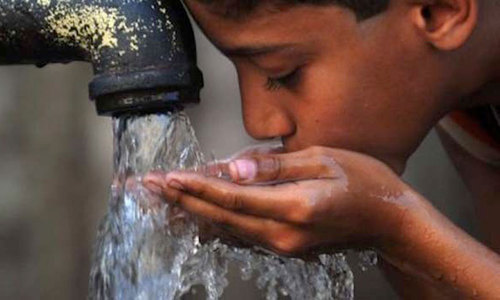81% of residents forced to buy drinking water. 90% of water sources unsafe, PCRWR reports. Karachi short by 550 million gallons daily.
KARACHI: A startling new report by the Pakistan Council of Research in Water Resources (PCRWR) has revealed that nearly half of Karachi’s population does not have access to safe drinking water, in a city now exceeding 20 million residents.
The report further warns that Pakistan could run out of drinking water by 2040 if urgent corrective measures are not taken.
According to the findings, 81% of Karachi’s residents are forced to purchase drinking water, as over 90% of water sources are contaminated with hazardous pollutants.
Bacterial contamination, unsafe chemical levels, and poor infrastructure are making clean water a luxury for many in Pakistan’s largest city.
Pakistan is currently ranked the third most water-stressed country in the world, with an accelerating water crisis linked to climate change, poor governance, population growth, and declining freshwater availability.
The situation is particularly severe in urban centres like Karachi, which is now facing the prospect of absolute water scarcity within the next 15 years.
Demand outstrips supply
The Karachi Water and Sewerage Board (KWSB) is responsible for the city’s water supply network, drawing around 95% of its water from the Indus River via Keenjhar Lake.
However, the city’s daily demand is 1,200 million gallons, while supply stands at only 650MGD, leaving a gap of 550MGD. This unmet demand has pushed residents, especially in low-income areas, toward illegal and unregulated water sources such as private tankers, oil refineries, and groundwater wells.
These alternatives often come at a high cost, financially and health-wise. Groundwater in Karachi contains salinity levels of 4,000–12,000PPM, far exceeding the World Health Organisation’s safe limit of 1,000PPM, making it unfit for human consumption.
According to the report, 41% of Karachi’s population lacks access to properly managed drinking water, and over 90% of water sources are biologically contaminated, contributing to widespread waterborne illnesses such as diarrhoea, typhoid, and hepatitis.
Vulnerable populations, particularly women, children, and the elderly, bear the brunt of these outbreaks.
The Sindh MICS 2017–2018 survey, published in 2021, revealed that 79.1% of source water in Karachi is contaminated with E. coli, while contamination levels rise to 85.5% at the household level, indicating severe risks throughout the water distribution system.
Infrastructure challenges
Karachi’s water infrastructure is plagued by leakages, illegal connections, ageing pipelines, and poor maintenance, leading to further contamination and massive water loss.
A survey found that 86% of respondents reported not receiving piped water from the KWSB in a long time. Instead, most residents depend on private suppliers, wells, or hand pumps, many of which are unreliable and unsafe.
Alarmingly, 42% of residents said they had never seen any government-led water quality testing in their area, and 58% were unaware of whether any testing had ever occurred.
This lack of regulation and transparency erodes public trust in the water supply system and leaves residents exposed to serious health hazards.
The KWSB, Karachi’s primary utility provider, continues to struggle with the crisis, hindered by financial mismanagement, political interference, and an inability to implement reforms.

